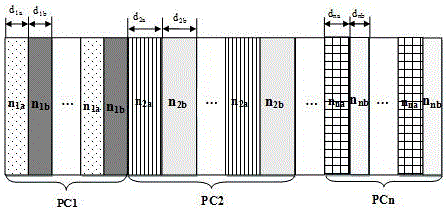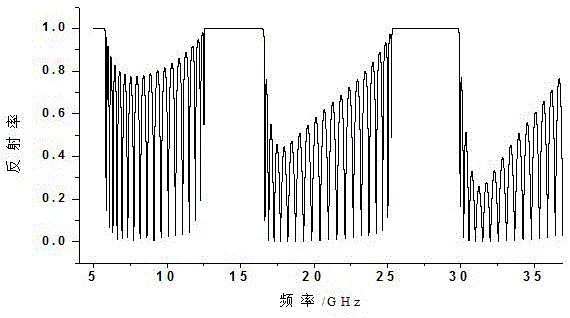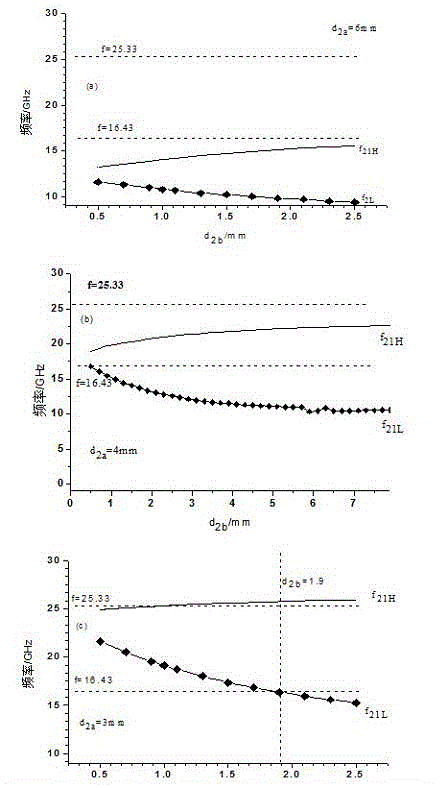One-dimensional cascaded plasma photonic crystal and omnibearing band gap maximization design method thereof
A plasmonic and photonic crystal technology, applied in the field of one-dimensional cascaded plasmonic photonic crystal and its omnidirectional bandgap maximization design
- Summary
- Abstract
- Description
- Claims
- Application Information
AI Technical Summary
Problems solved by technology
Method used
Image
Examples
Embodiment 1
[0023] see figure 1 , the one-dimensional cascaded plasmonic photonic crystal is composed of dielectric layers and plasma layers alternately stacked, and is characterized in that: making full use of multiple band gaps of PC, by making n bands of PCs cascaded in n phases The gap can be connected to each other for all polarization states of TM and TE in all incident angle ranges. For all polarization states of TM and TE in all incident angle ranges, the lower limit of the first band gap of PC2 is connected with the upper limit of the first band gap of PC1, and the upper limit of the first band gap of PC2 is connected with the upper limit of PC1 The lower limit of the second band of PC2 is connected with the upper limit of the second band of PC1, the upper limit of the second band of PC2 is connected with the third band of PC1 The lower limit is connected, and so on to n-level PC, n is a natural number except zero.
Embodiment 2
[0025] The omni-directional bandgap maximization design method of the above-mentioned one-dimensional cascaded plasmonic photonic crystal is characterized in that the specific design steps are:
[0026] (1) According to the known structural parameters of the previous PC, the upper and lower limits of the first, second, ..., nth band gaps are obtained at normal incidence;
[0027] (2) According to the fact that multiple band gaps of cascaded PCs can be connected to each other, determine the upper and lower limits of the first band slot, the second band slot, ..., the nth band slot of the next PC at normal incidence location area;
[0028] (3) Adjust the structural parameters of the latter PC, and preliminarily determine the structural parameters of the latter PC by making the position of each band gap of the latter PC meet the upper and lower limit position areas of each band gap determined in the previous step;
[0029] (4) Judging whether the light of all polarization s...
Embodiment 3
[0031] Take the cascaded structure of two plasma PCs as an example to illustrate the design of the maximum omni-directional bandgap based on the method of the present invention. The structure is as attached figure 1 shown. Here, the periods of the a and b media in PC1 and PC2 are selected as 20; the a media is a dielectric material with a refractive index of 2, and the a media of the two PCs are the same, that is, n 2a =n 1a =2; the b medium of the two PCs is also the same, that is, the dielectric constant of the b medium of PC1 e 1b and the dielectric constant of the b medium of PC2 e 2b for , where the electron plasma frequency , the collision frequency , w is the angular frequency of the incident light. The refractive index of medium b in PC1 and PC2 is then . Angular frequency of incident light w and incident light frequency f The relationship is w =2p f . Known a dielectric thickness d of PC1 1a =5mm, realize the omnidirectional reflector with maxim...
PUM
 Login to View More
Login to View More Abstract
Description
Claims
Application Information
 Login to View More
Login to View More - R&D
- Intellectual Property
- Life Sciences
- Materials
- Tech Scout
- Unparalleled Data Quality
- Higher Quality Content
- 60% Fewer Hallucinations
Browse by: Latest US Patents, China's latest patents, Technical Efficacy Thesaurus, Application Domain, Technology Topic, Popular Technical Reports.
© 2025 PatSnap. All rights reserved.Legal|Privacy policy|Modern Slavery Act Transparency Statement|Sitemap|About US| Contact US: help@patsnap.com



